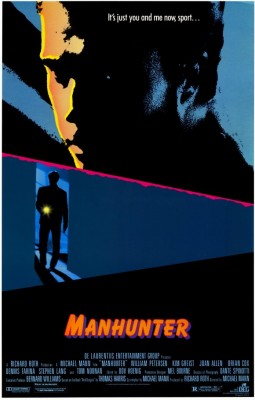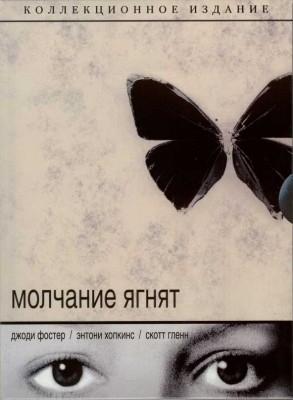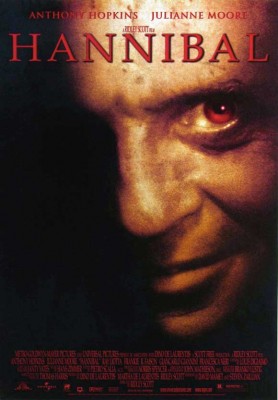| Reviews & Columns |
|
Reviews DVD TV on DVD Blu-ray 4K UHD International DVDs In Theaters Reviews by Studio Video Games Features Collector Series DVDs Easter Egg Database Interviews DVD Talk Radio Feature Articles Columns Anime Talk DVD Savant Horror DVDs The M.O.D. Squad Art House HD Talk Silent DVD
|
DVD Talk Forum |
|
|
| Resources |
|
DVD Price Search Customer Service #'s RCE Info Links |
|
Columns
|
|
|
Hannibal Lecter Collection (Manhunter / The Silence of the Lambs / Hannibal), The
Manhunter (1986), from Thomas Harris's 1981 novel Red Dragon, was the first movie to introduce Hannibal Lecter, the brilliant former psychiatrist-turned-cannibalistic serial killer, but he plays a minor role in the story and is onscreen for just seven of the film's 120 minutes, and played here by Brian Cox. Lecter-mania was to come later, with the release of The Silence of the Lambs, though Manhunter did earn some rave reviews if mixed box-office at the time, and gradually developed a well-deserved cult following.
Former FBI agent Will Graham (William Petersen) is pressed back into service by his former boss, Jack Crawford (Dennis Farina), after his agents run into a brick wall in their investigation of "The Tooth Fairy," a serial killer slaughtering entire families with every lunar cycle. Graham is reluctant to get involved; he left the agency after barely surviving an encounter with another infamous serial killer, Dr. Hannibal Lecktor (sic); Graham nearly died in his struggle with Lecktor and was so traumatized by the process of relating to his prey in order to capture him that Graham ultimately required psychiatric hospitalization.
Nevertheless, Graham accepts Crawford's assignment, but things get complicated when sleazy tabloid journalist Freddy Lounds (Stephen Lang) reveals Graham's involvement in the pages of The Tattler (read: National Enquirer), and later when Dr. Lecktor, now held in a maximum security prison, is discovered to be corresponding with the killer, Francis Dollarhyde (Tom Noonan).
Directed by Michael Mann, Manhunter was one of the first movies to reflect the growing influence of flashy, high-concept television and music videos. It's a highly stylized film, but for the most part not relentlessly attention-grabbing at the expense of character and story like so many high-concept films today. What might have been mildly distracting in 1986 today comes off as comparatively restrained, though Mann still goes overboard here and there. For instance, exteriors of the prison holding Lecktor are actually the High Museum of Art and that's what it looks like: an art museum, not a prison in any practical sense. Lecktor's cell is all-white, like a laboratory, and that's fine, but Mann and his art director/set decorator carry this design to the office of Lecktor's keeper, Dr. Chilton (Benjamin Hendrickson), going so far as to give him an all-white office too: white stapler, white paper clips, Wite-Out, white everything. Characters also enjoy luxurious surroundings far beyond their apparent means. Dollarhyde, for instance, lives in an out-of-the-way house that's so architecturally interesting - I don't know where it was filmed - it's hard to believe a man with his salary could afford it, like a refrigerator repairman living in a house by Frank Lloyd Wright. Fortunately though, Mann's visual sense is arresting in positive ways most of the time, reflecting the mood of the characters in interesting ways.
As a character study-police procedural, Manhunter is superb. It slowly peels away at Graham's backstory concerning Lecktor and how it nearly ruined his relationship with his family, while his methodical if dangerous methods are believable and exciting. In many ways Manhunter bridges two phases of American crime shows: it exhibits the influence of TV's oh-so-hip Miami Vice in particular (on which Mann was an executive producer) while anticipating by nearly 15 years CSI - Crime Scene Investigation, on which Petersen essentially played a less-troubled variation of the same character doing the same type of investigative work.
An excellent actor in other things - I especially like his performance in the little seen Hidden Agenda (1990) - Brian Cox makes a very believable but not especially charismatic Hannibal Lecktor. His Lecktor is outwardly blasé, extremely clever but human, where Anthony Hopkins would be a literal mad genius, and almost if not quite superhuman. Noonan, on the other hand, is almost clinical in a disturbingly real performance. That his character commits such unspeakable acts yet almost comes off as sympathetic - Graham feels sorry for the little boy transformed into a monster, while Dollarhyde has a sweet/horrifying romance with a blind co-worker, Reba (Joan Allen in an early performance) - is a testament to Noonan's skill.
The picture is extremely tense and exciting, and deserves points for being so without resorting to a lot of graphic onscreen trauma. Though rated "R" most of the violence occurs off-camera. (**** out of *****)
The Silence of the Lambs is less flashy but the ingenuity of the filmmakers, particularly director Jonathan Demme, editor Craig McKay, and cinematographer Tak Fujimoto, along with the superb performances all around, make this a deserving Best Picture Oscar-winner in a decidedly weak year. The film was a monstrous commercial success as well, grossing almost $300 million on a budget of just $19 million, but while the film became a bona fide pop culture phenomenon, it wasn't enough to save its producer, Orion Pictures, from bankruptcy a few years later.
The story mirrors the plot of Manhunter in many ways but with a few significant differences. FBI Behavioral Science chief Jack Crawford (now played by Scott Glenn) sends FBI student Clarice Starling (Jodie Foster) on a trivial but interesting assignment, so he says. He wants her to try to persuade Hannibal Lecter (now played by Anthony Hopkins) to answer a routine questionnaire, but Crawford's real motive is to use the vulnerable Starling as bait. He's hoping she'll unwittingly motivate Lecter into helping the FBI track down "Buffalo Bill," a serial killer preying on young, overweight women.
Intrigued by Starling's tragic, rural West Virginia background Lecter, who may already know the wanted serial killer's identity, agrees to help - provided Starling reveals to him stories of her unhappy upbringing: quid pro quo.
At the Baltimore State Hospital where Lecter is held, Lecter's ambitious, sadistic keeper, Dr. Frederick Chilton (here played by Anthony Heald), isn't happy Starling is keeping him out of the loop, and conspires to use secretly recorded audio to advance his own career. Meanwhile, Catherine Martin (Brooke Smith), coincidentally the daughter of a U.S. Senator (Diane Baker), is kidnapped by "Buffalo Bill" (Ted Levine). Can Starling extract the vital clues from Lecter before it's too late?
The Silence of the Lambs is superb. The claustrophobic framing and clever editing stand out - note how they manipulate the audience as the FBI closes in on "Buffalo Bill's" home - the haunting score by Howard Shore blankets the film with a feeling of minor key dread even over the opening titles, appropriately lettered in black. As a thriller, it's extraordinarily intense. I remember seeing it on opening day in a packed theater, and about three-quarters of the way through the movie there's a genuinely shocking twist that so caught the audience off-guard that I witnessed (and was part of) something I've never experienced in a movie theater before or since: the entire audience simultaneously shuddered. It was like being hit with a sonic shock wave.
While audiences found Levine's creepy serial killer conventionally if effectively disturbing, Hopkins' Lecter became a media sensation. His dialogue - practically every line - was quoted endlessly and soon parodied by stand-up comics and on TV shows. Surprisingly, Hopkins even recorded a telephone answering machine greeting as Lecter (included as an extra on this disc). That the film and Hopkins' performance remains as riveting today as it did almost 20 years ago reflects its visceral power.
But Hopkins and Lecter are onscreen for just 17 minutes, and what really makes The Silence of the Lambs the classic modern horror-thriller it is mainly is due to Foster's compelling Clarice Starling. Regardless of the film's genre, Starling is one of the most realistically strong and determined women to appear in a mainstream American movie. Forget overrated claptrap like Out of Africa: Clarice Starling is a real woman overcoming sexism, physical limitations (she's tiny compared to most of her fellow students), economical hardships, regional prejudices (Lecter calls her "one generation removed from poor white trash"), childhood trauma, inexperience, and many other hurdles over the course of this film. It's no accident the picture opens with Starling jogging through the FBI's obstacle/training course (with words like "hurt," "agony," and "pain" posted along the way).
Thus, a good part of the film's appeal is Lecter's recognition of Starling's qualities, and their strange, certainly unique monster-teacher-analyst / interrogator-student-patient relationship. Though his words and actions horrify her, they simultaneously push her into coming to terms with who she is, and who she's capable of becoming. Despite its disturbing subject matter, The Silence of the Lambs is really a starkly feminist film in sheep's clothing. (*****)
Despite the initial enthusiasm of Foster, Hopkins, Demme, and others involved with Silence of the Lambs to make another, the sequel, Hannibal, took a full decade to appear and proved not at all worth the long wait. Harris's 1999 novel of the same name read almost like a reaction to the popular success of the film of Lambs, and the generally faithful adaptation, despite its significantly altered ending, both indulged audience expectations while virtually rejecting everything that had made Silence of the Lambs so good.
Ten years after the events in the previous film, FBI agent Clarice Starling (now played by Julianne Moore) is disgraced in a drug sting that goes wrong and where five people are killed - though she was blameless (rendering the clumsy if showy action sequence rather pointless when you consider it). An obnoxious justice department official, philistine Paul Krendler (Ray Liotta), who unsuccessfully tried to seduce Starling years before, wants to make her the scapegoat but she's returned to duty when new information about fugitive Hannibal Lecter (Hopkins) comes to light.
Clues lead Starling to Lecter's only surviving victim - conveniently forgetting Will Graham, who's never mentioned* - super-wealthy but disfigured and paralyzed Mason Verger (Gary Oldman), a pedophile ex-patient of Dr. Lecter's, goaded into self-mutilation. Verger, who looks like The Phantom of the Opera and talks like Jimmy Stewart (who played a super-wealthy paraplegic in 1978's The Big Sleep, perhaps not coincidentally), is trying to use Clarice as bait in order to capture Lecter for himself and to exact his unspeakable revenge: he wants to slowly feed Lecter to his trained pigs.
Lecter, meanwhile, has been busy establishing a new identity in Florence, but Chief Inspector Rinaldo Pazzi (Giancarlo Giannini) of the Questura stumbles upon Lecter's real idenity**, and conspires with Verger's agents to deliver Lecter to him instead of the law.
Hannibal goes wrong in so many ways it's hard to know where to begin. Perhaps responding to the public's fascination with Lecter, the movie makes the fatal mistake of turning him into the co-main character when he should have remained a supporting one. The audience sees far too much of him, even when it's not necessary: as Verger recalls his violent encounter with Lecter it's shown in flashback. Soon after, grainy B&W surveillance footage gives way to clear full-color footage of Lecter. Starling listens to audio tapes of Lecter throughout, including highlights from the last movie (though less effectively reenacted by Hopkins and Moore). It's like the filmmakers are straining to give Hopkins as much screentime as possible, to justify his justly huge paycheck. Moore, meanwhile, has almost no character to play.
Though undeniably one of the best actresses working in films today, Julianne Moore is miscast, though on a second viewing (for the first time since its initial release) the problem has more to do with the writing than her. That after 10 years Starling would have gained as much boundless confidence as Moore exudes is a stretch, but her poor, West Virginia roots buried deep inside (but still always visible, especially to Lecter) have vaporized in Moore's portrayal.
Where Foster's Starling was determined and assertive, Moore's constantly loses control of the situation at hand: at the drug raid, trying to restrain Inspector Pazzi, attempting to capture Lecter at various opportunities, etc. She's never even one step behind Lecter; for most of the film she's literally a continent away.
Add to that, the film is generally unpleasant before it becomes flat-out repellent. Except for Starling, the other major characters consist of a cannibalistic serial killer, a disfigured child molester (who escaped justice), a corrupt Justice Department official, and a corrupt Italian cop. Good ol' ex-hospital orderly Barney (Frankie R. Faison, reprising his role in Lambs), whose basic decency is laughably established when he gently cradles a dead pigeon that he scoops out of the gutter, is secretly selling Lecter memoribilia to the highest bidder. Even the FBI Starling so longed to be a part of is shown here as irretrievabley dishonest. This is a deeply cynical film.
It also completely falls apart during the last 15 minutes, as Verger unleashes his snarling pigs and Lecter whisks Starling away for a night of Grand Guignol, horrors that were never a part of either Manhunter or Lambs, despite their unjust reputation by some as simple "serial killer" movies. What unfolds is impressively realistic enough that it made appalled 2001 audiences (and 2009 ones, for that matter) genuinely queasy, but by this point the film has devolved into something resembling an expensive-looking but crassly manufactured "dare film" along the lines of an Italian shockumentary; the intensely personal drama of Silence of the Lambs and much of Manhunter now seems a million miles away.
Ridley Scott's distracting direction doesn't help, as is the concession to dumb, subtitle-intolerant Americans by having all the Italian characters speak English, even to one another - in Florence. The structure is no good: there's not only too much of Lecter in the first-half, there's also zero suspense because the audience is all too aware Pazzi's no match at all for the mad genius, now more the cultured James Bond super-antihero who pretentiously lectures about Dante and takes tins of (only the finest) caviar with him when flying. First class, of course. (**)
Video & Audio
Manhunter looks great - filmed in Super 35/J-D-C Scope its highly detailed image and very fine, very pleasing level of film grain and superb color (shot on Eastman stock with original prints by Technicolor) impresses, and best exemplified by Mann's liking of beautiful sunsets and crystal clear tight shots of FBI crime reports. Originally Dolby Stereo, its 5.1 DTS-HD Master Audio (on all three films) doesn't add a whole lot - it still sounds very much like a mid-level mid-'80s release, but it's not bad. This version of the film runs just shy of 120 minutes.
The 1.85:1 Silence of the Lambs and Hannibal are less impressive. There seems to have been some effort to soften the grainy, deliberately muddy look of Lambs, and there's a strange strobing effect whenever there's any sudden motion: note how Dr. Chilton's hands blur at 51:48. Hannibal, new to Blu-ray, seems to have been sourced from an old high-def transfer, or maybe the reason it looks so unimpressive - the weakest of the three films, oddly enough - is that a 25GB single-layer disc has been used, versus the 50GB dual-layer discs for the other two. All three films include 5.1 Dolby Digital Audio in French and Spanish, while Lambs offers a few additional languages, as per its earlier release.
Extra Features
Manhunter and Hannibal have no extra features, while Silence of the Lambs is identical to the extras-packed Blu-ray release from this past March. Included are the lengthy featurettes (several hours worth) Breaking the Silence, Understanding the Madness, Inside the Labyrinth: Making of The Silence of the Lambs, The Silence of the Lambs: Page to Screen, Scoring the Silence, and the Original 1991 Making Of Featurette.
Also included are more than 20 minutes of Deleted Scenes and Outtakes, along with the aforementioned Anthony Hopkins Phone Message plus TV Spots and Trailers.
Parting Thoughts
So what you have are three films which are Very Good, Excellent, and Extremely Disappointing and that evens out to six-plus hours of mostly strong and intelligent entertainment and mixed transfers, plus a lot of extras accompanying the best film, averaging out to a Recommended release.
*Before Hannibal was published, many fans assumed the new novel would team Graham and Starling, that they'd work together in an effort to capture Lecter. That might have made an excellent movie.
** On an FBI database, Lecter is listed among the agency's "10 Most Wanted" along with Osama bin Laden - in a film released seven months prior to 9/11.
Stuart Galbraith IV's latest audio commentary, part of AnimEigo's forthcoming Tora-san DVD boxed set, is available for pre-order, while his latest book, Japanese Cinema, is in bookstores now.
|
| Popular Reviews |
| Sponsored Links |
|
|
| Sponsored Links |
|
|
| Release List | Reviews | Shop | Newsletter | Forum | DVD Giveaways | Blu-Ray | Advertise |
|
Copyright 2024 DVDTalk.com All Rights Reserved. Legal Info, Privacy Policy, Terms of Use,
Manage Preferences,
Your Privacy Choices | |||||||


















